Lambertville, NJ. The two most intriguing lots on Rago’s Modern Design auction (January 22, 2021) were 573 and 576, respectively, Lizbeth Stewart’s Dog with Bones and Standing Cat. Our editor’s playful title suggests a degree of skepticism. And I have left that stand. That has always been the case with Stewarts work, it was seen by the field as too precious.
Their appearance in this auction causes a moment to reconsider her standing. Her art has been off the scene for long enough that her two animals here have the shock of the almost-new. And the experience, for this writer at least, is surprisingly positive.
They have a Koonsian quality (think of his porcelain Banality series that was launched in 1988 just after Stewart’s works were made). Now their obsessive craft has a newly revealed laconic, ironic and iconic edge. They look back at the viewer with a cockiness, daring one to question their exquisite silky handling of materials and a deft perfection in painting.
I have come away from this encounter greatly impressed. Alas, a great opportunity to acquire the works, with reasonable estimates and rare appearance in the market, was lost when both lots were passed.
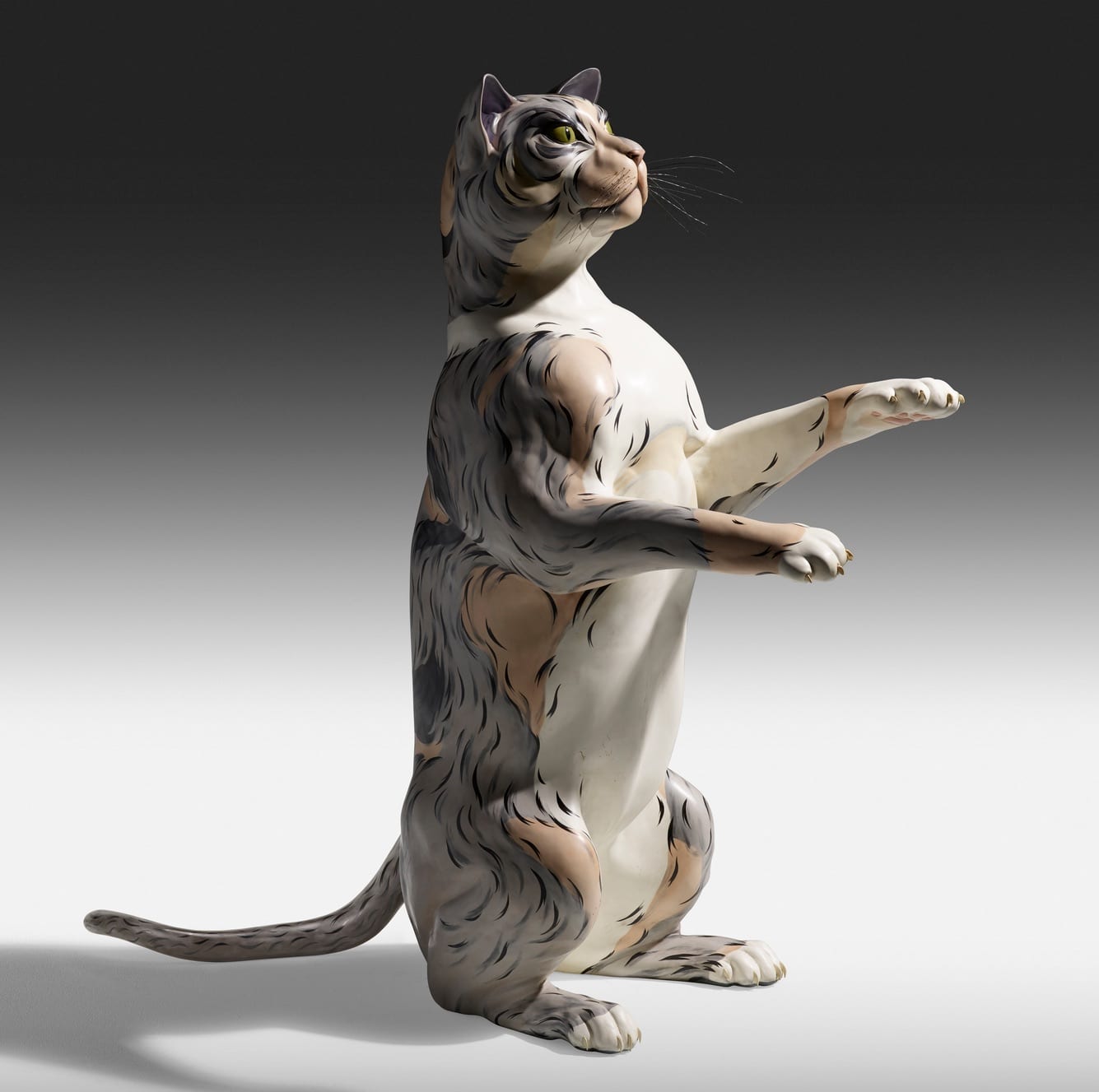

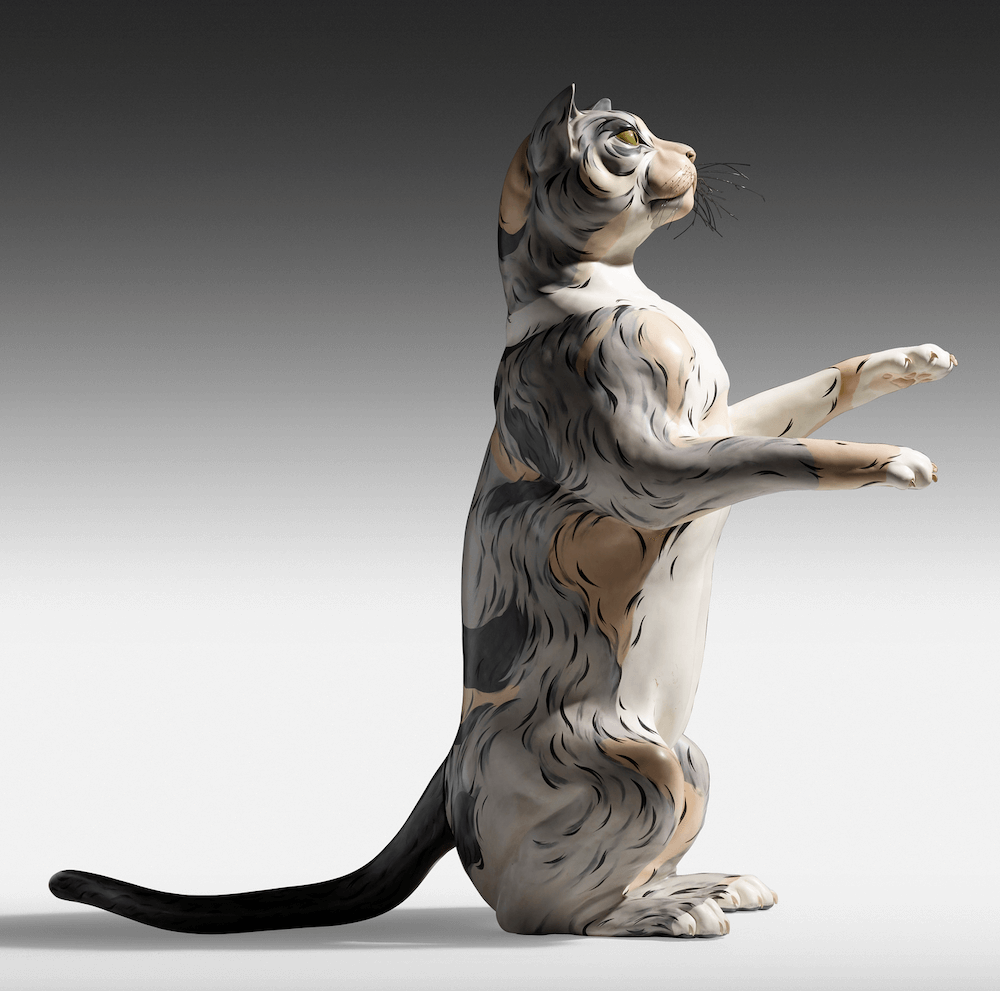
Lizbeth Stewart
Standing Cat
USA, 1983-84
glazed, fired, and hand-painted earthenware
38 h × 12 w × 41¼ d in97 × 30 × 105 cm
estimate: $8,000–12,000
In the essay on Stewart by Helen Drutt for the exhibition catalog, she rightly locates it as having “few parallels within contemporary American ceramics. Her sculptural tableaus are episodic, enigmatic, and elusive, and they are executed with meticulous precision endowed with haunting elegance”.
A possible exception is the work of Jack Earl but his ceramic dogs, despite their obvious sophistication, remain leashed to a folk art proposition. Stewart on the other hand tells us that her pets are to the manor born. They reveal a level of manual perfection that is innately costly in time to achieve.
Drutt adds further insights into these two works:
Standing Cat (1983-84) and Dog with Bones (1986) are exemplary of Stewart’s protracted exploration of these domesticated animals set in different familiar yet decontextualized poses or situations. Their patinas are intentionally rendered to look like linoleum, emphasizing a domesticated realism set apart from her earlier practice of fantastic realism.
Standing Cat is among the rare examples that have no additional elements, such as a reptile or bird, to drive the work’s narrative. Instead, the animal is shown with its gaze fixated on something we can’t see, leaving the viewer to imagine the rest of the composition. Dog with Bones shows the creature not with a cliché chew toy or meat shank; rather, the bones are splintered and belong to an animal larger than the dog, suggesting an act of predatory violence.

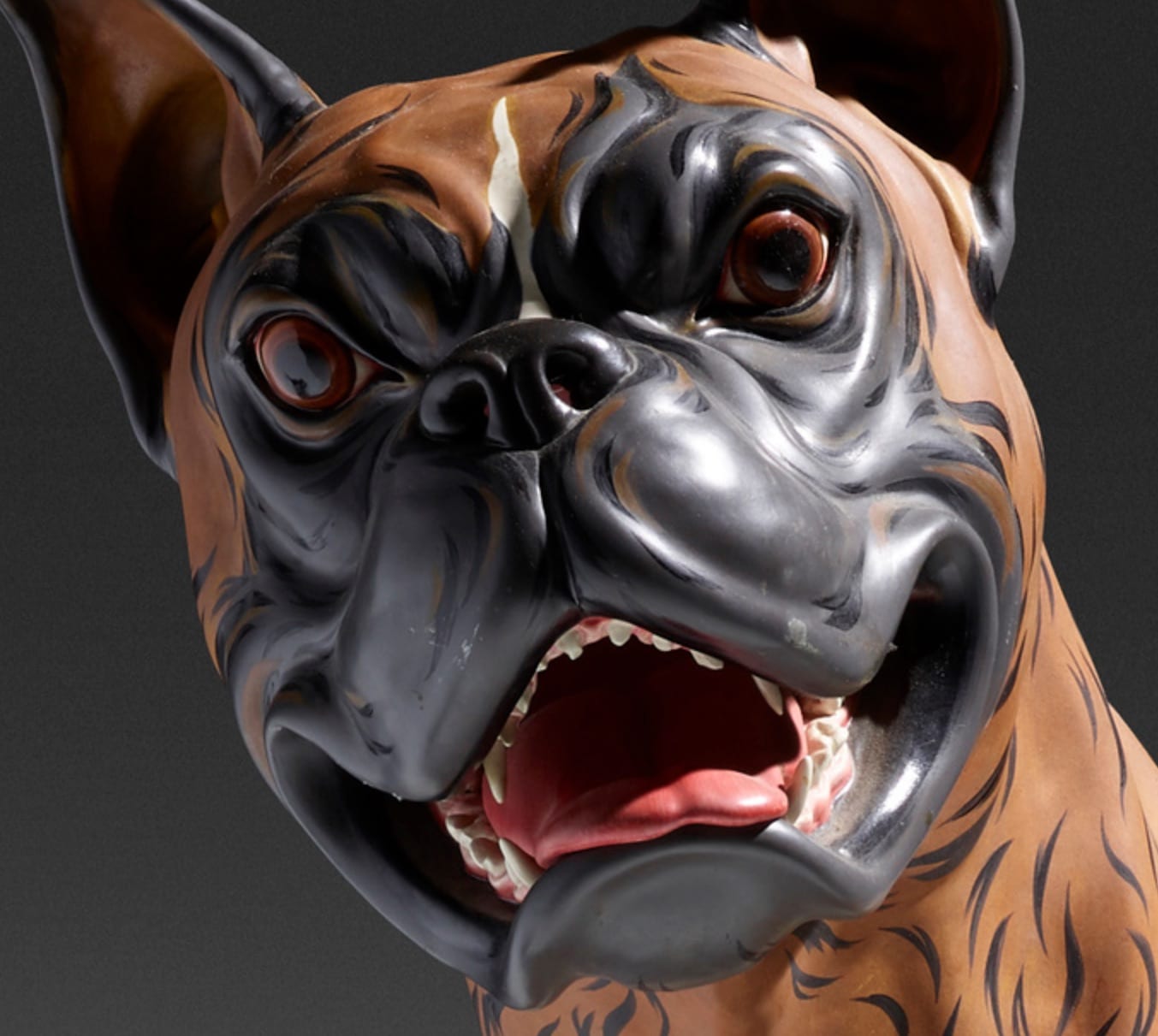
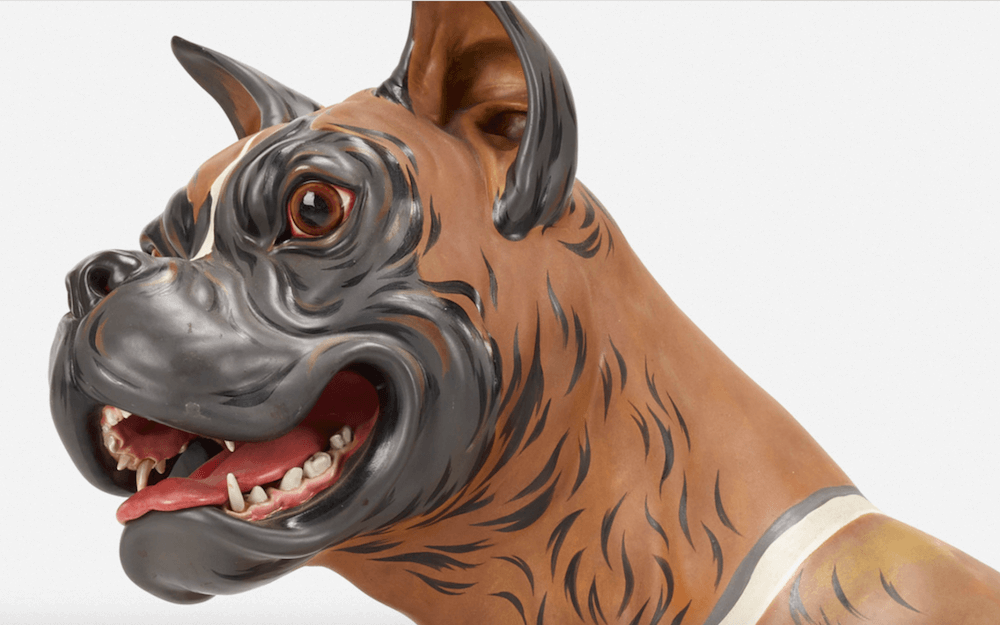
Lizbeth Stewart
Dog with Bones
USA, 1986
glazed, fired, and hand-painted earthenware
38½ h × 21 w × 31 d in98 × 53 × 79 cm
estimate: $9,000–14,000
The work on this auction by Voulkos was strangely pale (compared to the striking group offered a year ago) and lacked his usual forcefulness. The real excitement came from Betty Woodman and Toshiko Takaezu and their powerful and exceptional pieces that fetched respectable prices and proves their resilience.
As before Michael Lucero’s prices were embarrassing. He is a good artist and his visual wit has rarely been more pronounced than with Untitled for the Afro-Italian Series, a 2011 play on African antiquities, made in Postmodernism’s most promiscuous period of appropriation, dangerous ground to play with today. But Lucero neutralizes outrage. Instead of traditional grass and animal, the skirt is made up of knotted ties that suggest the closet of a white businessman. While not quite Gordian this work’s reverse gaze has a delicious complexity and deserved to fetch more than the paltry hammer price of $2,600 for this five-foot-tall work.
Lastly, the ‘small is beautiful’ trend (scroll to the bottom) with Lucie Rie continues in Phillips Online Design Auction (February 10, 2021) otherwise this was a lackluster sale for ceramics. These tiny pieces now get much more per centimeter than larger more imposing works. This began with a surging prices for her chawan and yunomi tea bowl sized forms and have continued down into Lilliput-land.
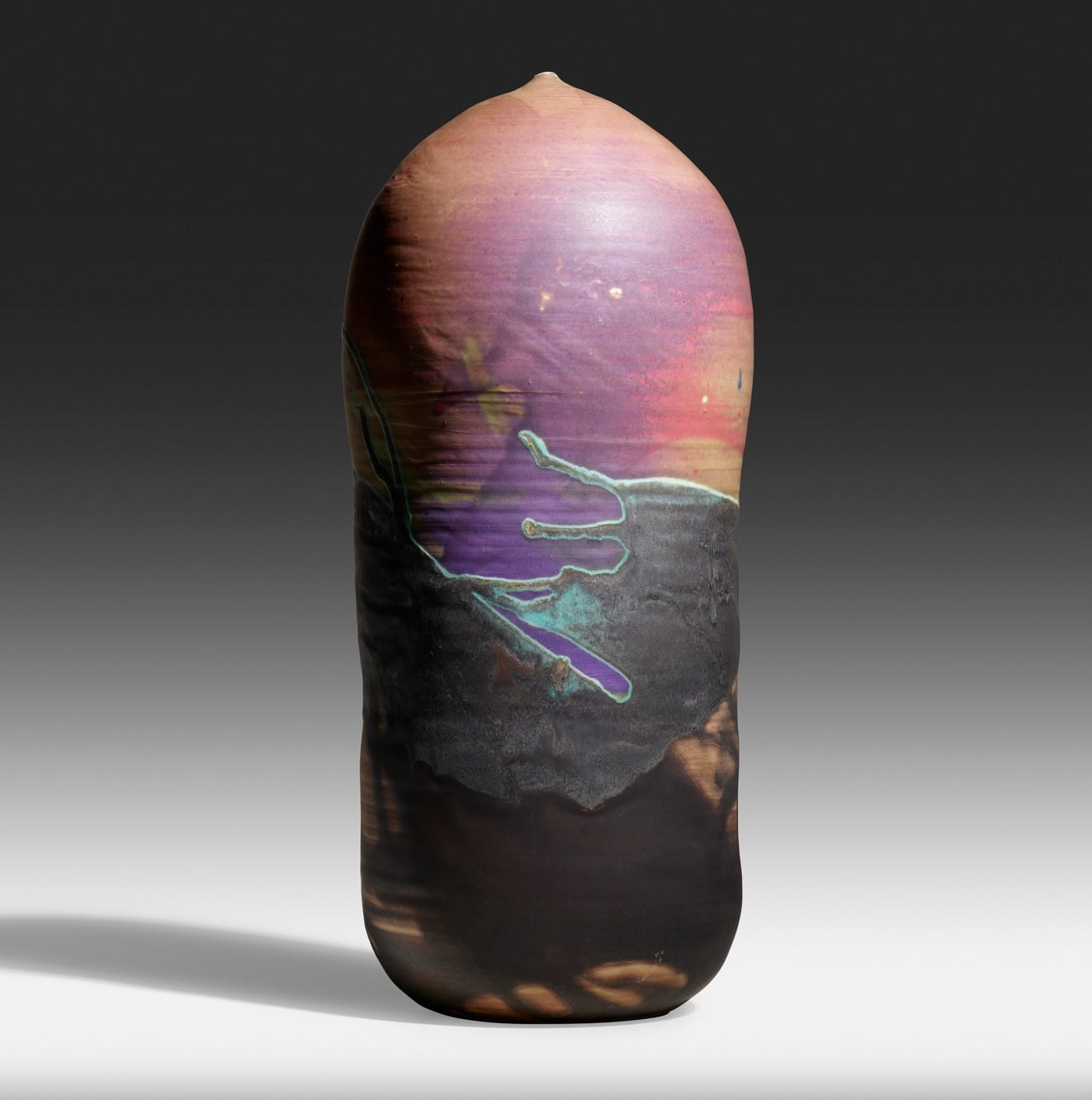
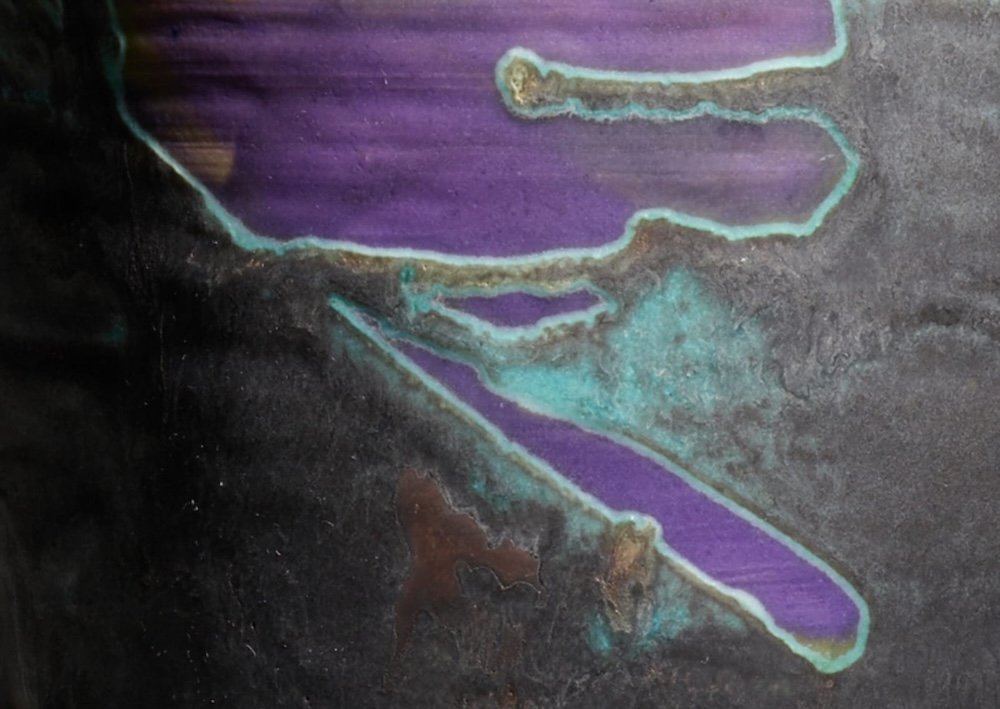
Toshiko Takaezu
Ocean Edge Closed Form
USA, c. 1990
glazed porcelain
14¾ h × 6¼ dia in37 × 16 cm
estimate: $9,000–12,000
result: $20,000
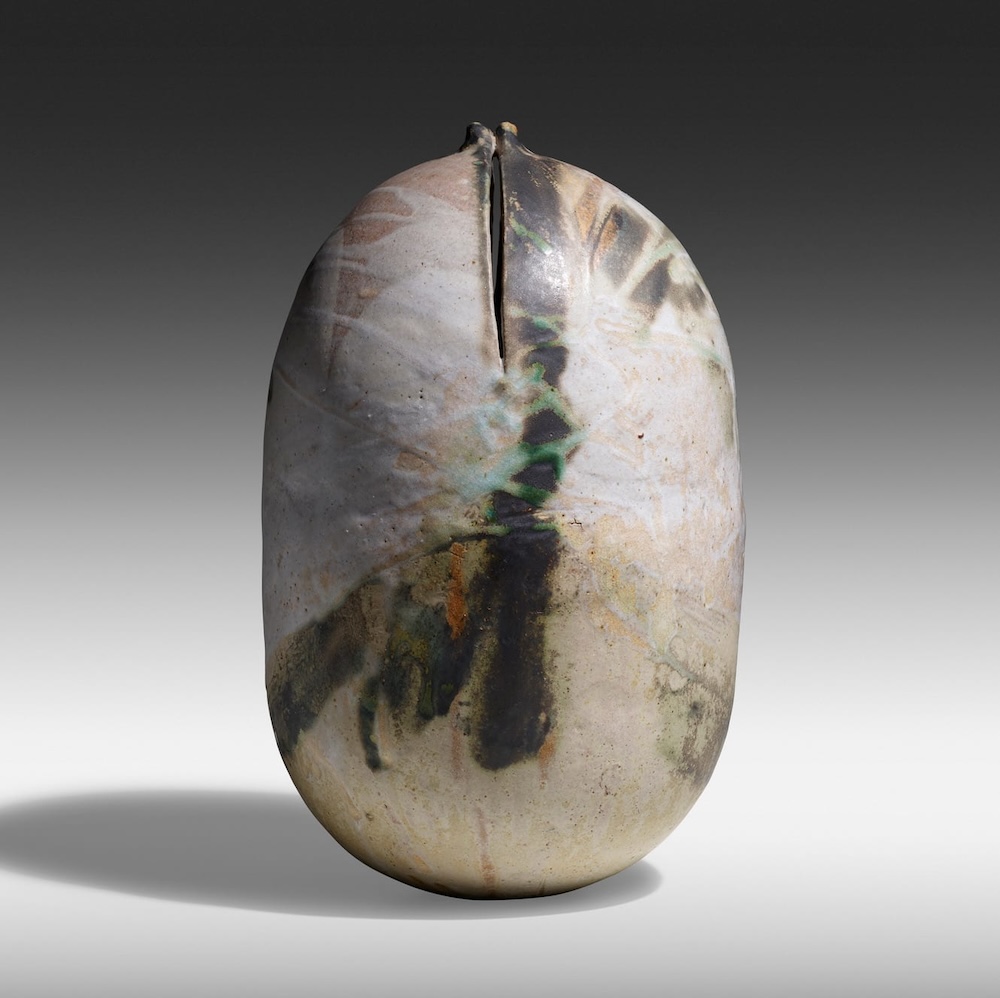
Toshiko Takaezu
Momo Form
USA, c. 1985
glazed stoneware
17¾ h × 10¾ dia in45 × 27 cm
estimate: $7,000–9,000
result: $30,000
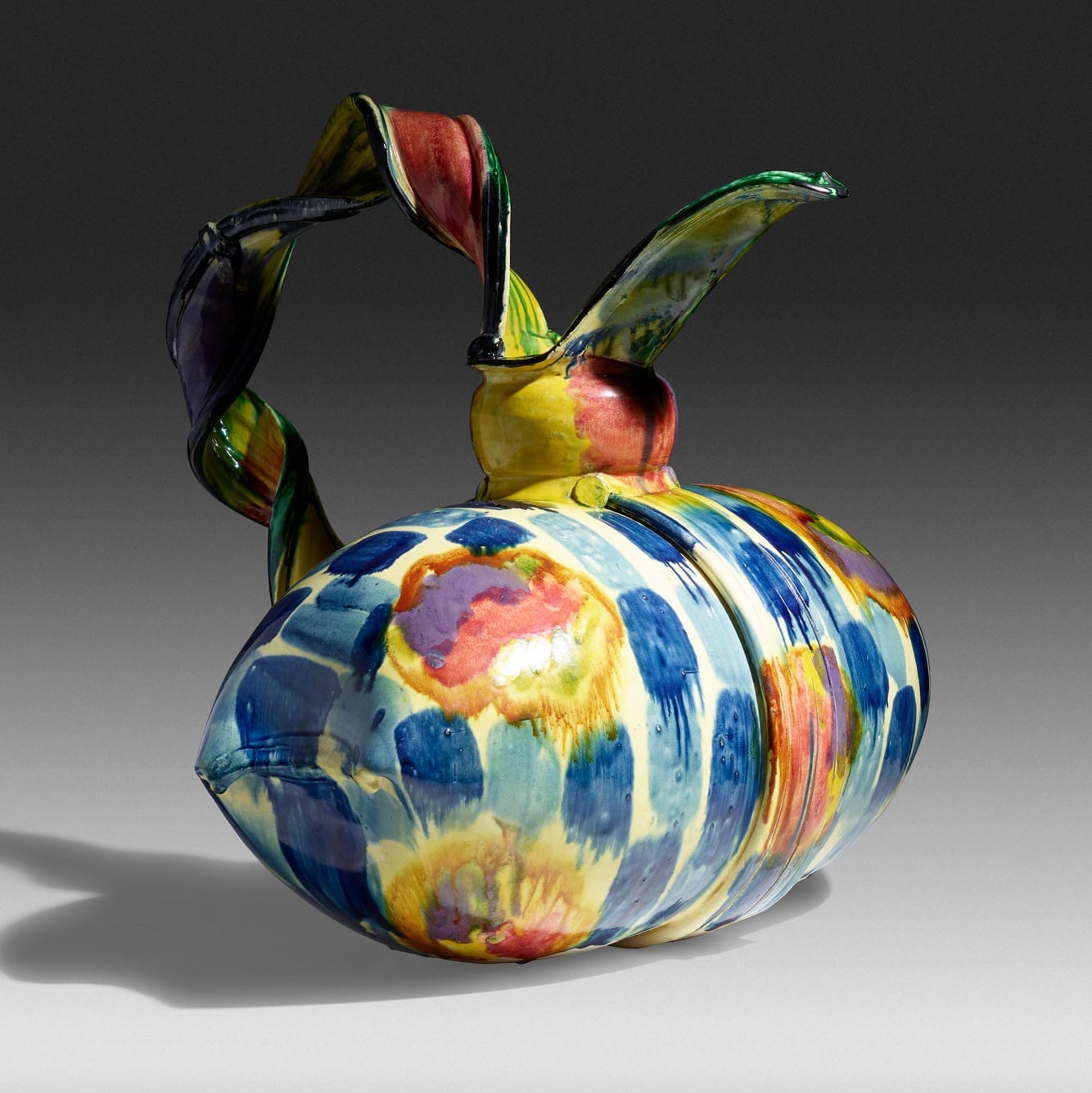
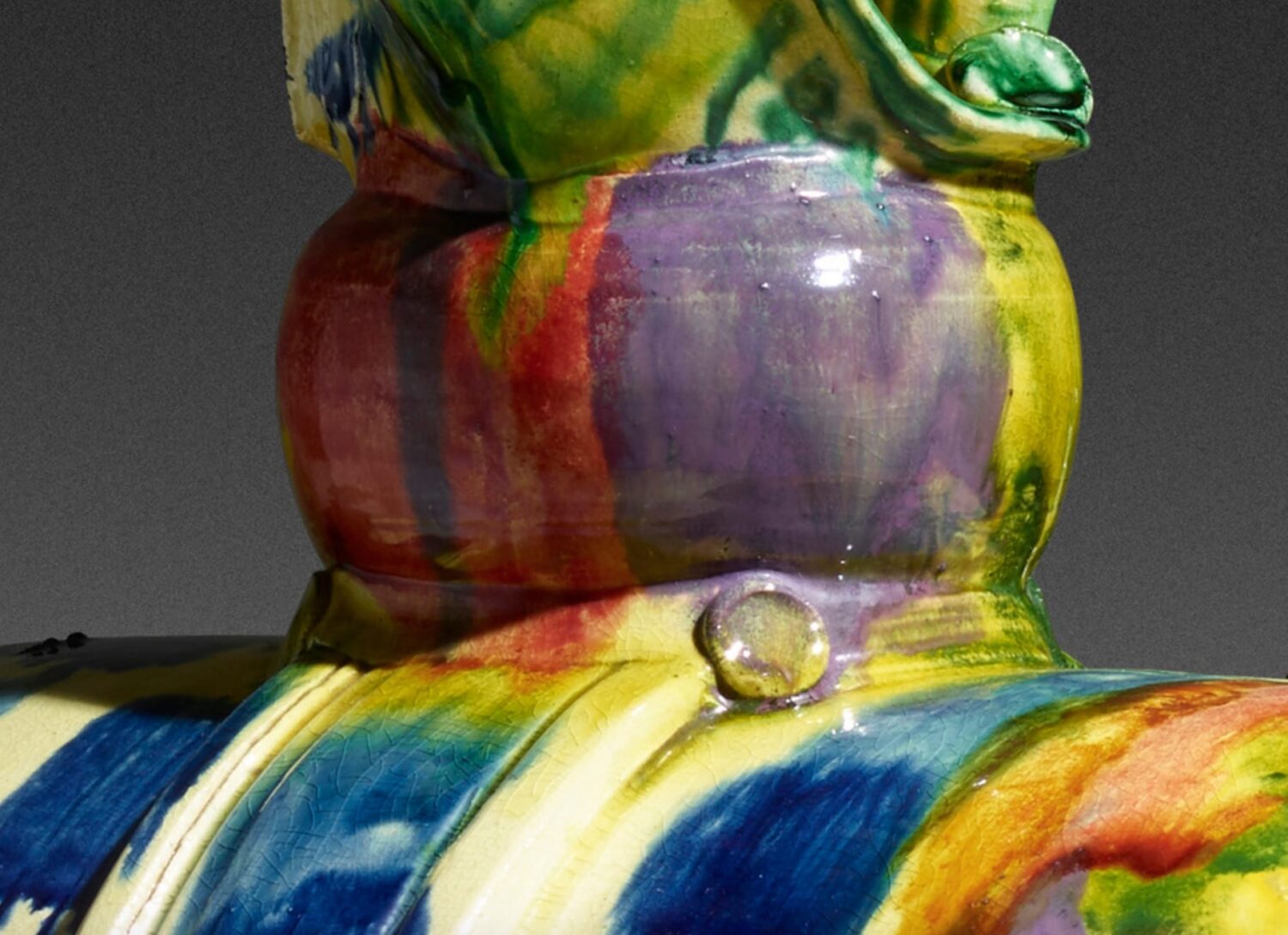
Betty Woodman
Pillow Pitcher
USA, c. 1985
glazed earthenware
21 h × 24 w × 20 d in53 × 61 × 51 cm
estimate: $15,000–20,000
result: $52,500
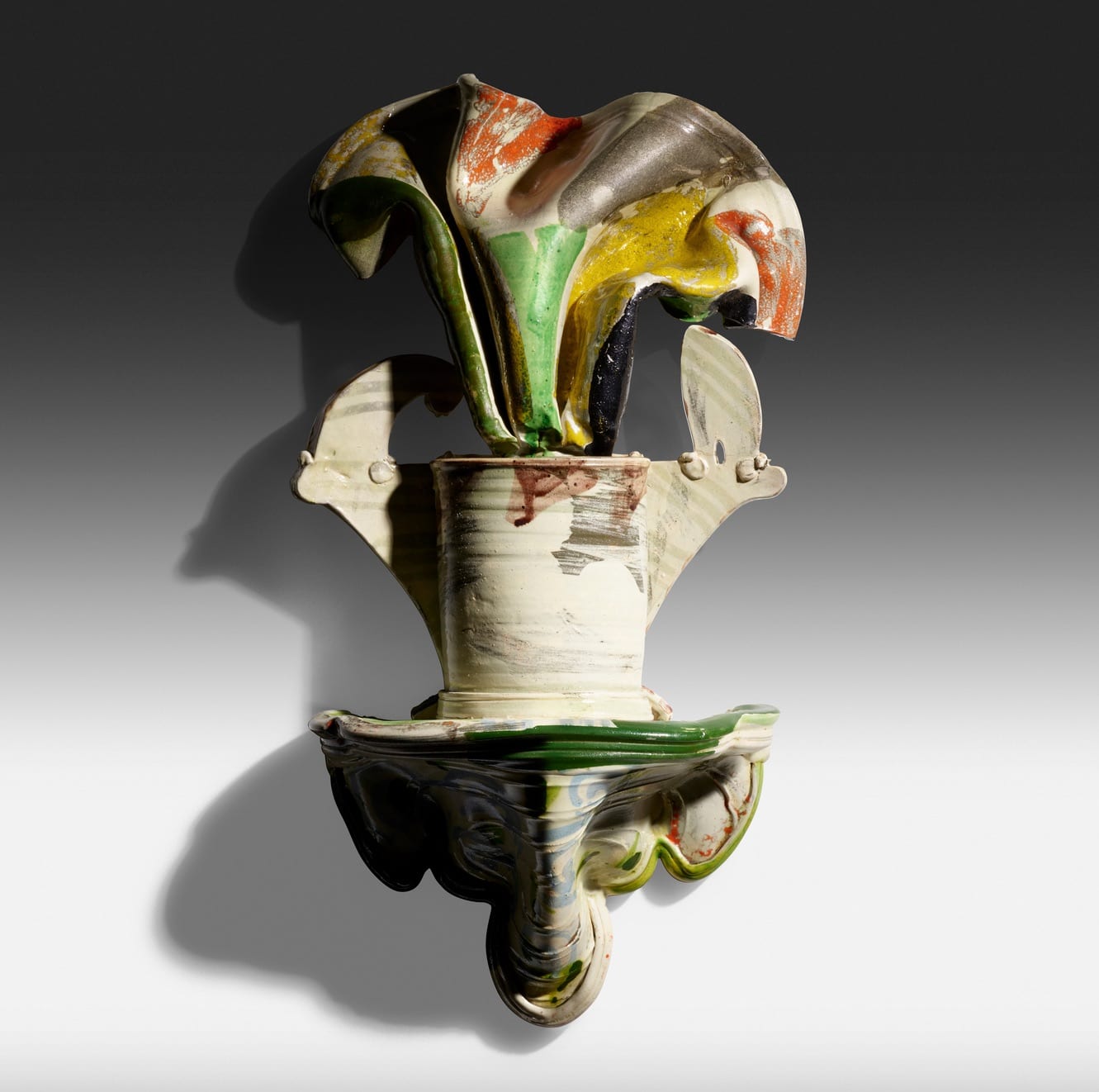
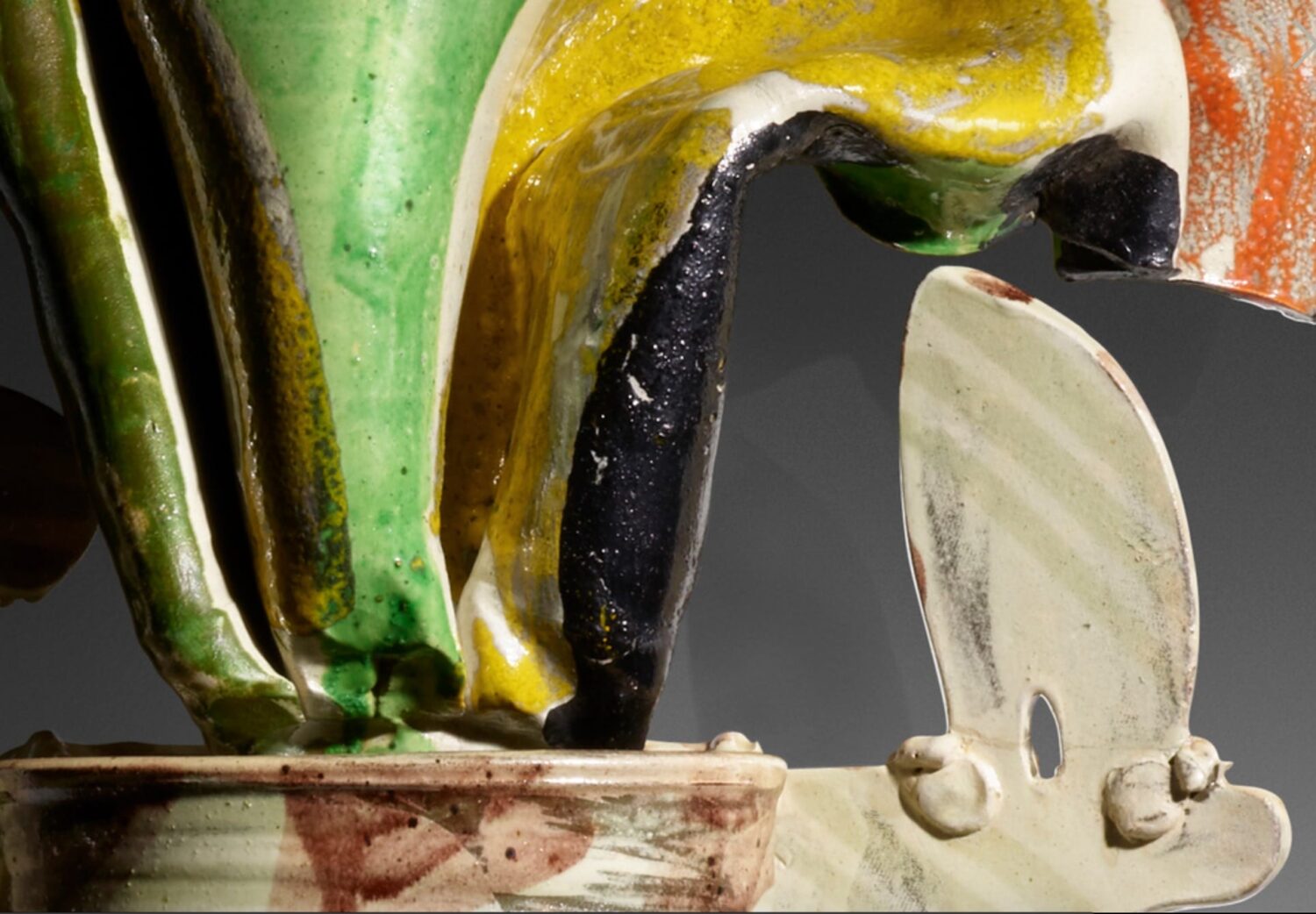
Betty Woodman
Pansy Shelf Vase
USA, c. 1990
glazed earthenware, epoxy resin, lacquer, paint
28 h × 15½ w × 7½ d in71 × 39 × 19 cm
estimate: $15,000–20,000
result: $21,250
In case you are confused with the use of the Japanese terms for the tea drinking vessel definitions.net offers an answer: a yunomi is a form of teacup, typically made from a ceramic material, being taller than wide, with a trimmed or turned foot. Unlike the more formal chawan tea bowl, which is used during the Japanese tea ceremony, the yunomi is made for daily tea drinking.
Overall, auctions are now sorting out the resale market for modern and contemporary ceramics. There is more predictability in hammer price and the market is also deciding which of the past ceramic stars will have a secondary market. As this process works, that list becomes ever smaller, and, on a positive note, more demanding aesthetically.
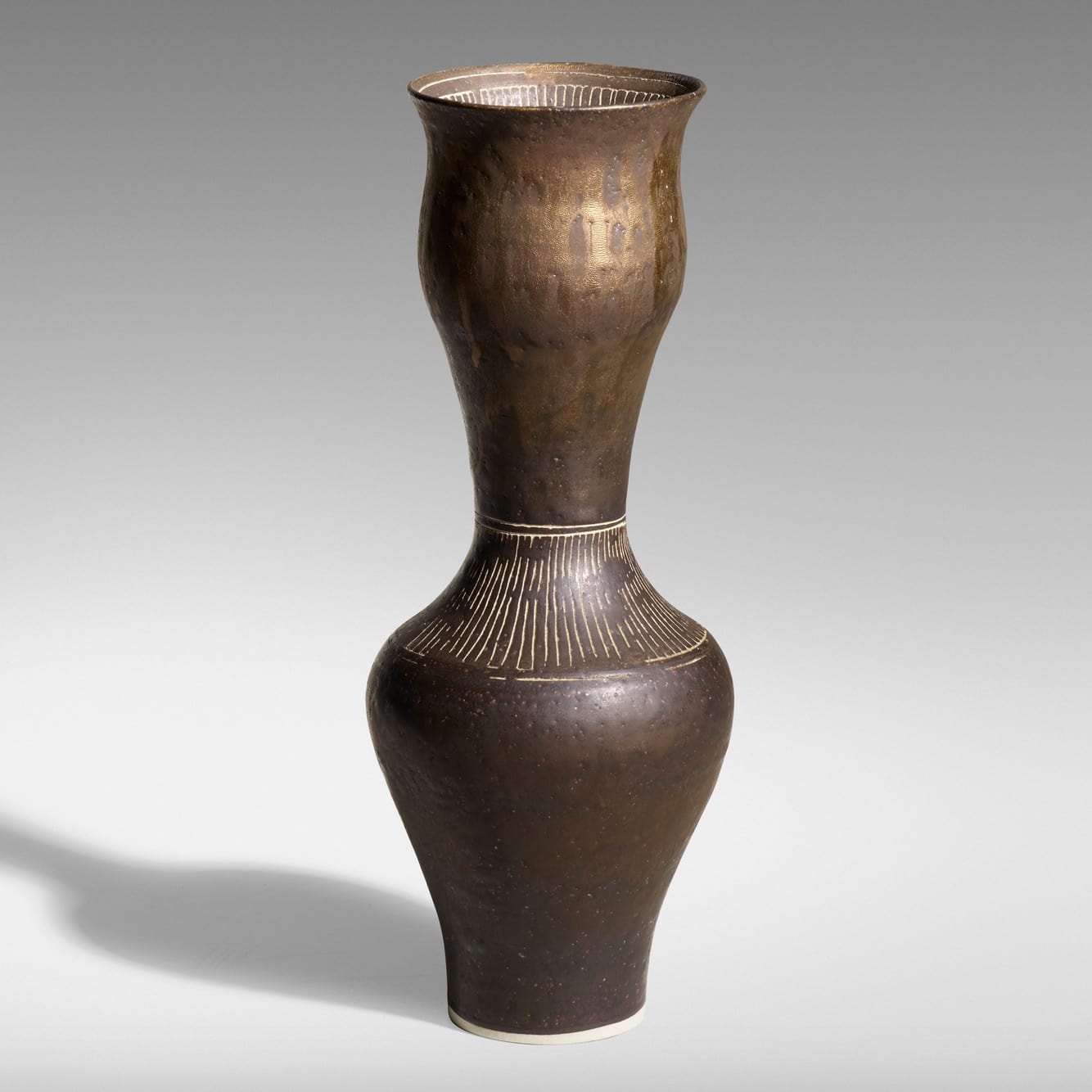
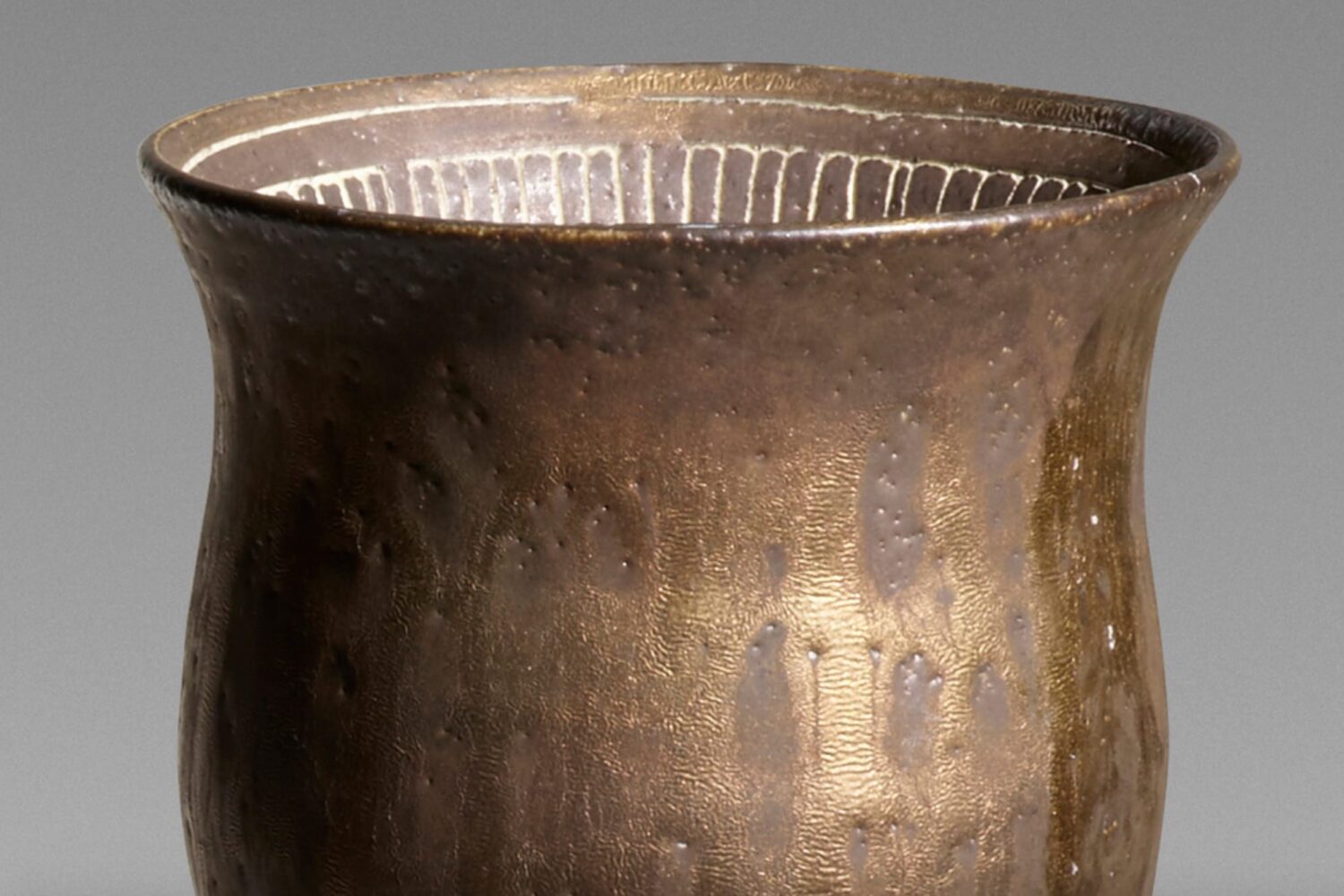
Lucie Rie
Bottle
United Kingdom, c. 1972
glazed porcelain with sgraffito decoration
11 h × 4 dia in28 × 10 cm
estimate: $5,000–7,000
result: $8,125

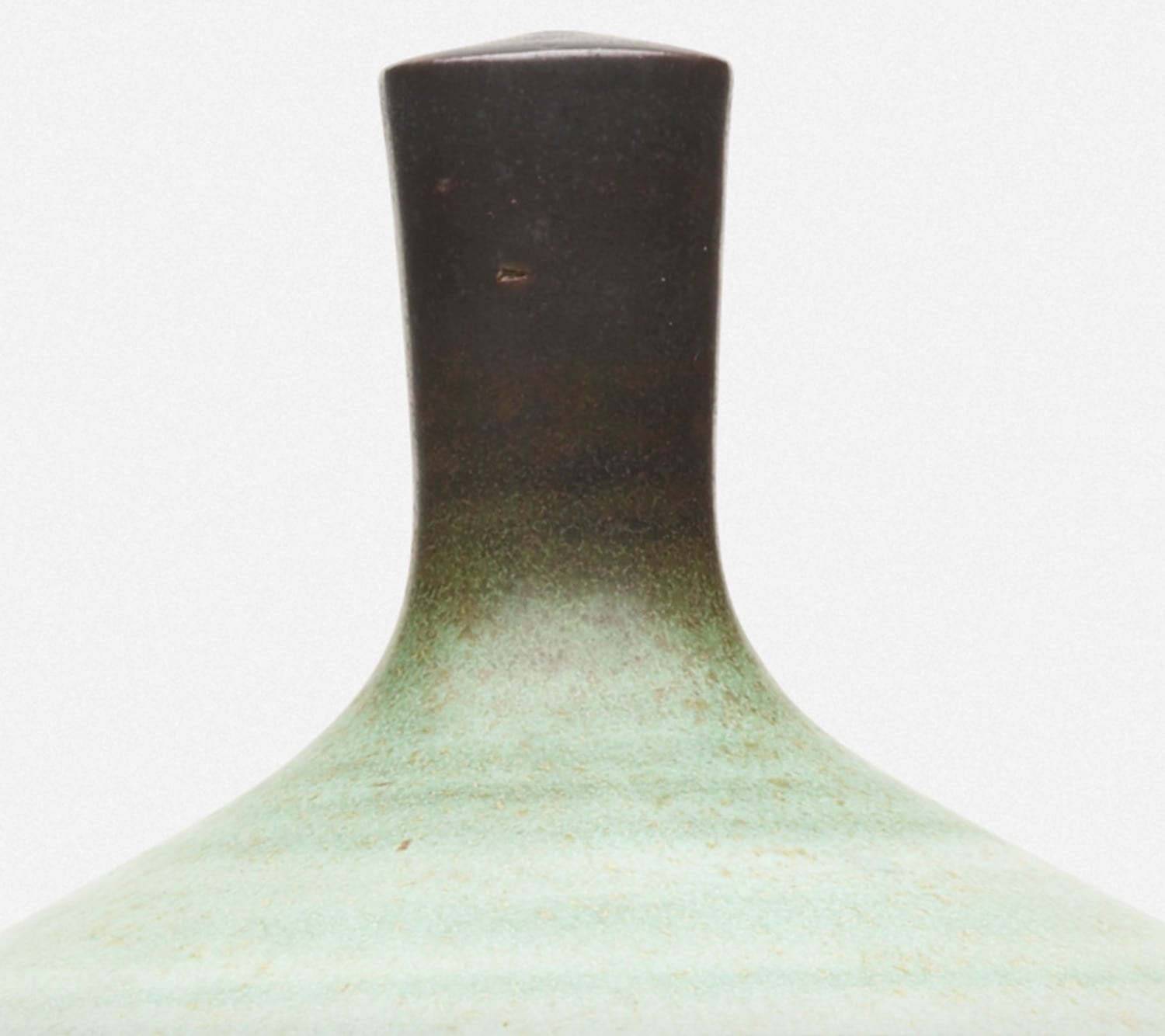
Harrison McIntosh
Covered vessel
USA, 1981
glazed stoneware
10¼ h × 6¼ dia in26 × 16 cm
estimate: $2,000–3,000
result: $4,375

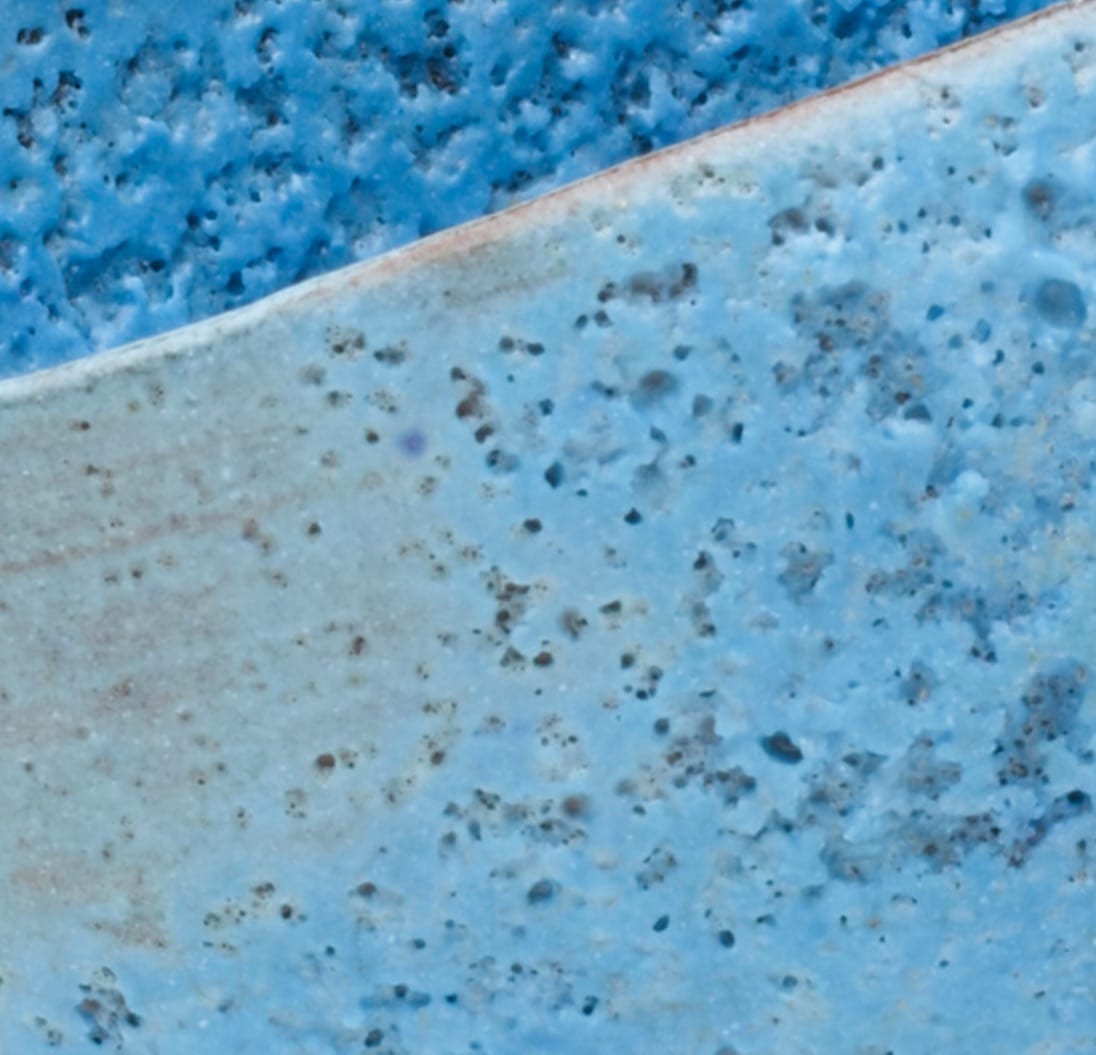
Beatrice Wood
Folded vessel
USA
volcanic glazed earthenware
3¼ h × 6½ w × 3¾ d in8 × 17 × 10 cm
estimate: $1,500–2,000
result: $2,750
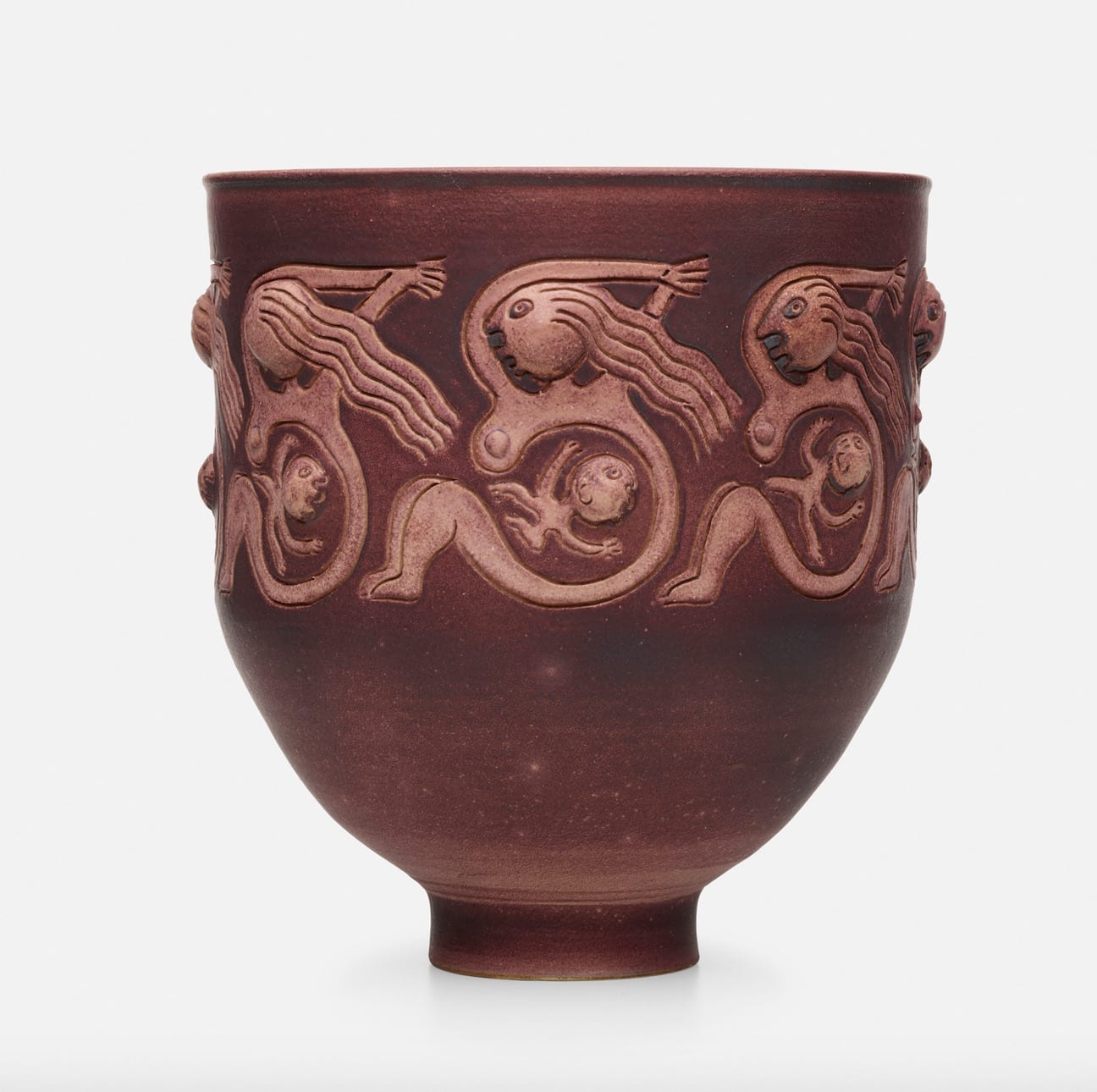

Edwin and Mary Scheier
Large vessel
USA, 1992
carved and glazed stoneware
12½ h × 12½ dia in32 × 32 cm
estimate: $2,000–3,000
result: $1,875
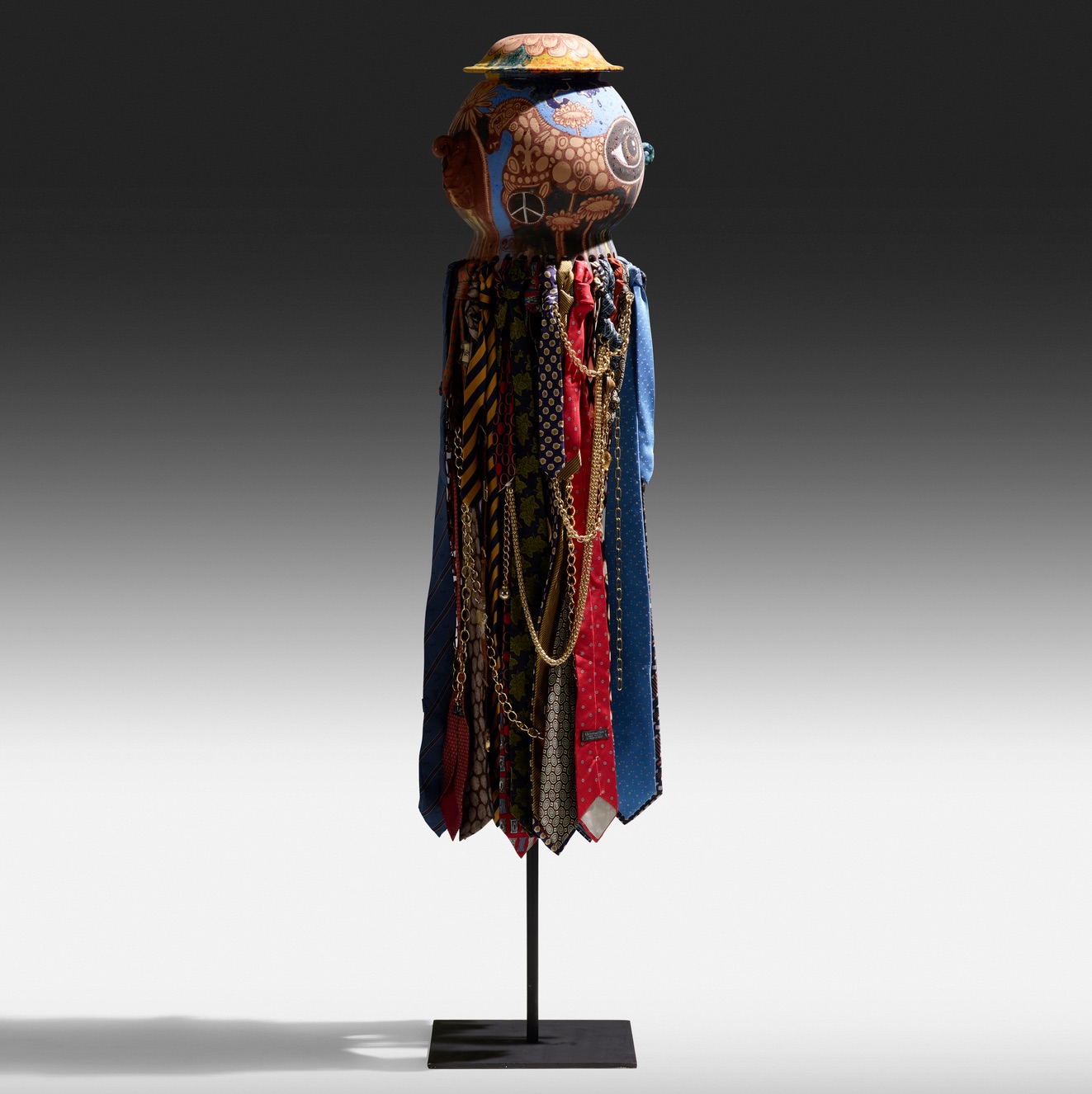
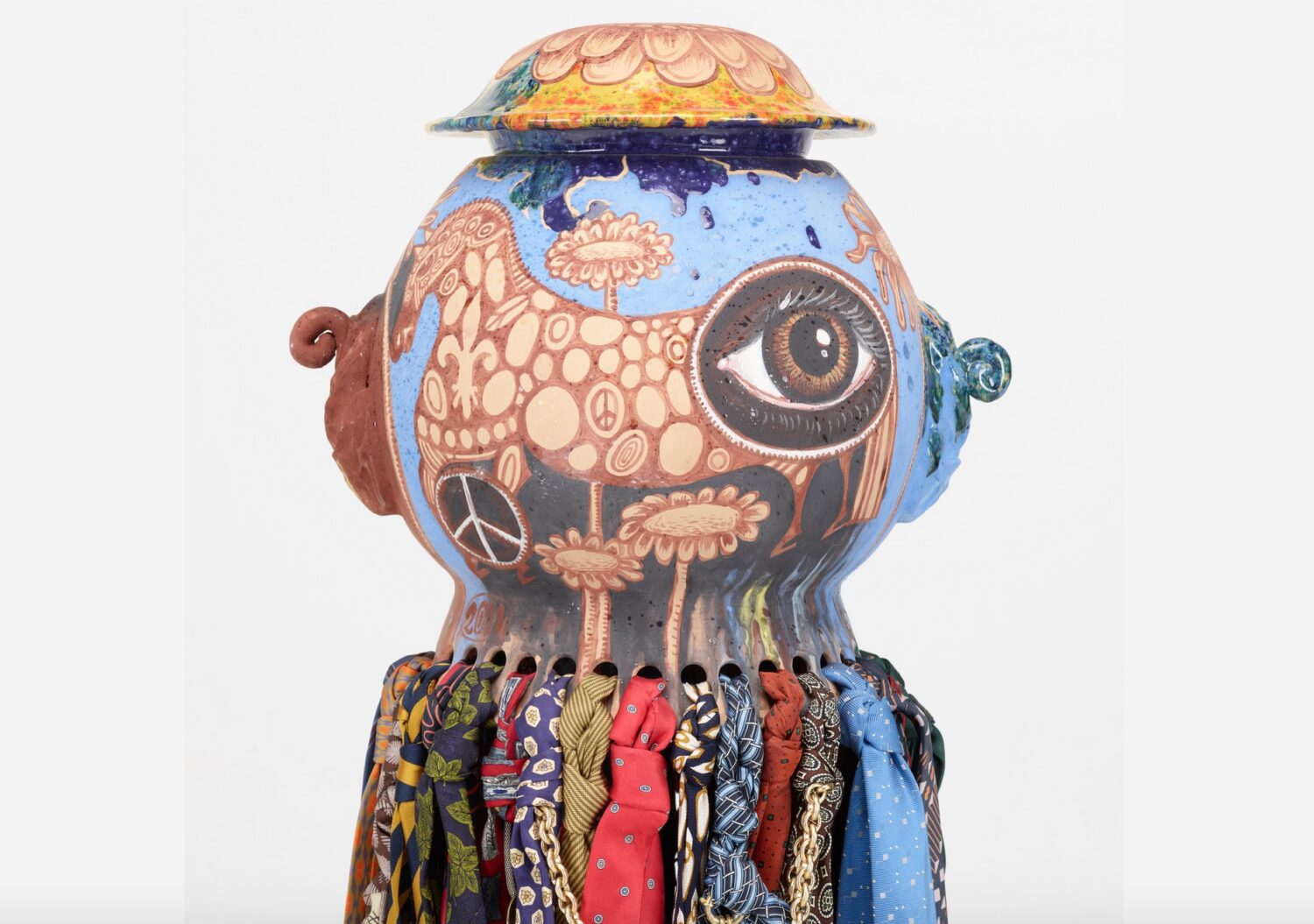
Michael Lucero
Untitled from the Afro-Italian series
Italy, 2011
glazed and bisque ceramic, mixed media, enameled steel
60½ h × 12¾ w × 12¾ d in154 × 32 × 32 cm
estimate: $2,500–3,500
result: $2,600
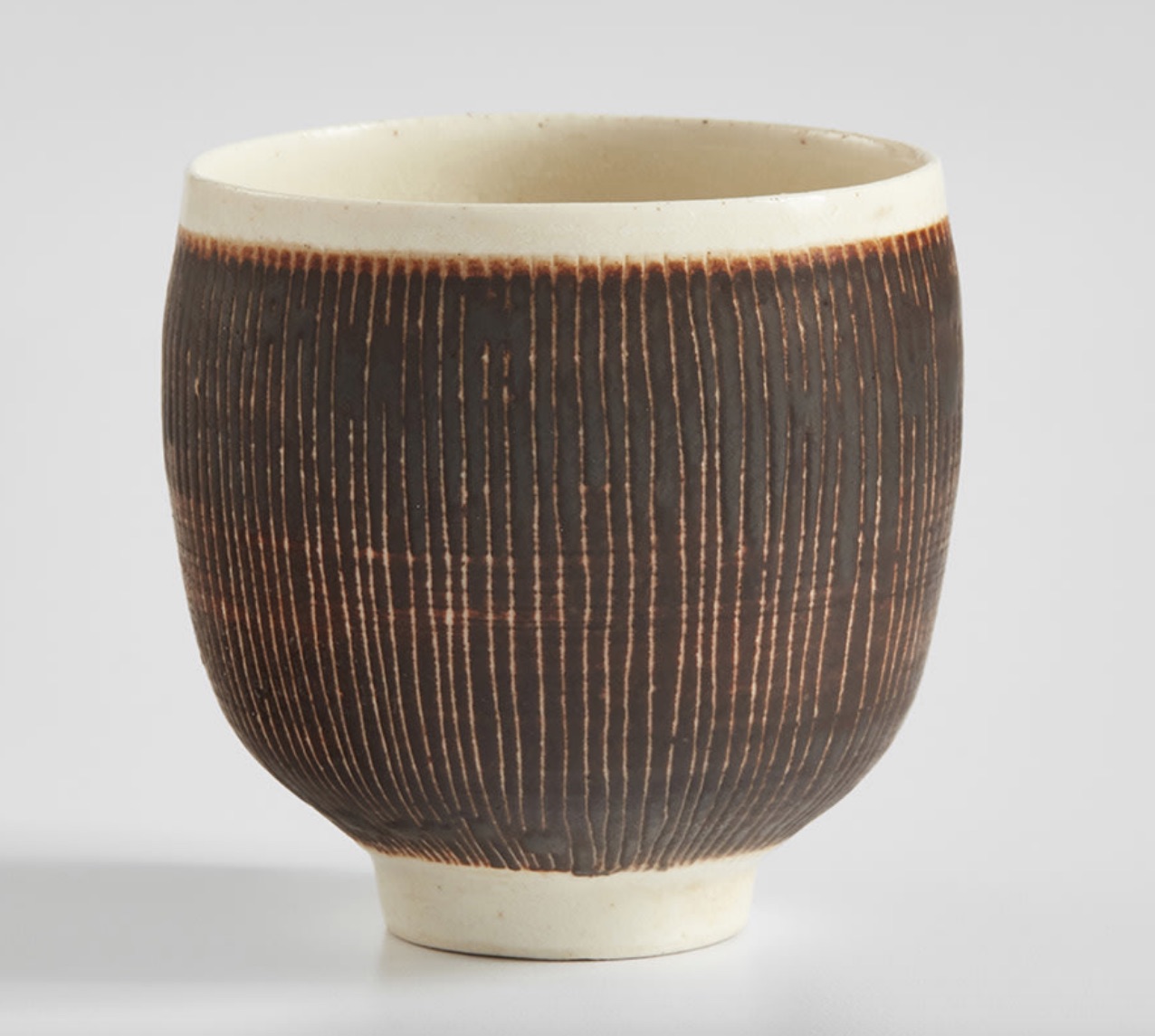
Lucie Rie
Sugar bowl
circa 1952
Porcelain, white glaze and manganese glaze with sgrafitto design.
2 3/4 in. (7 cm) high
Underside impressed with artist’s seal.
Estimate
$1,000 – 1,500
SOLD FOR $5,292

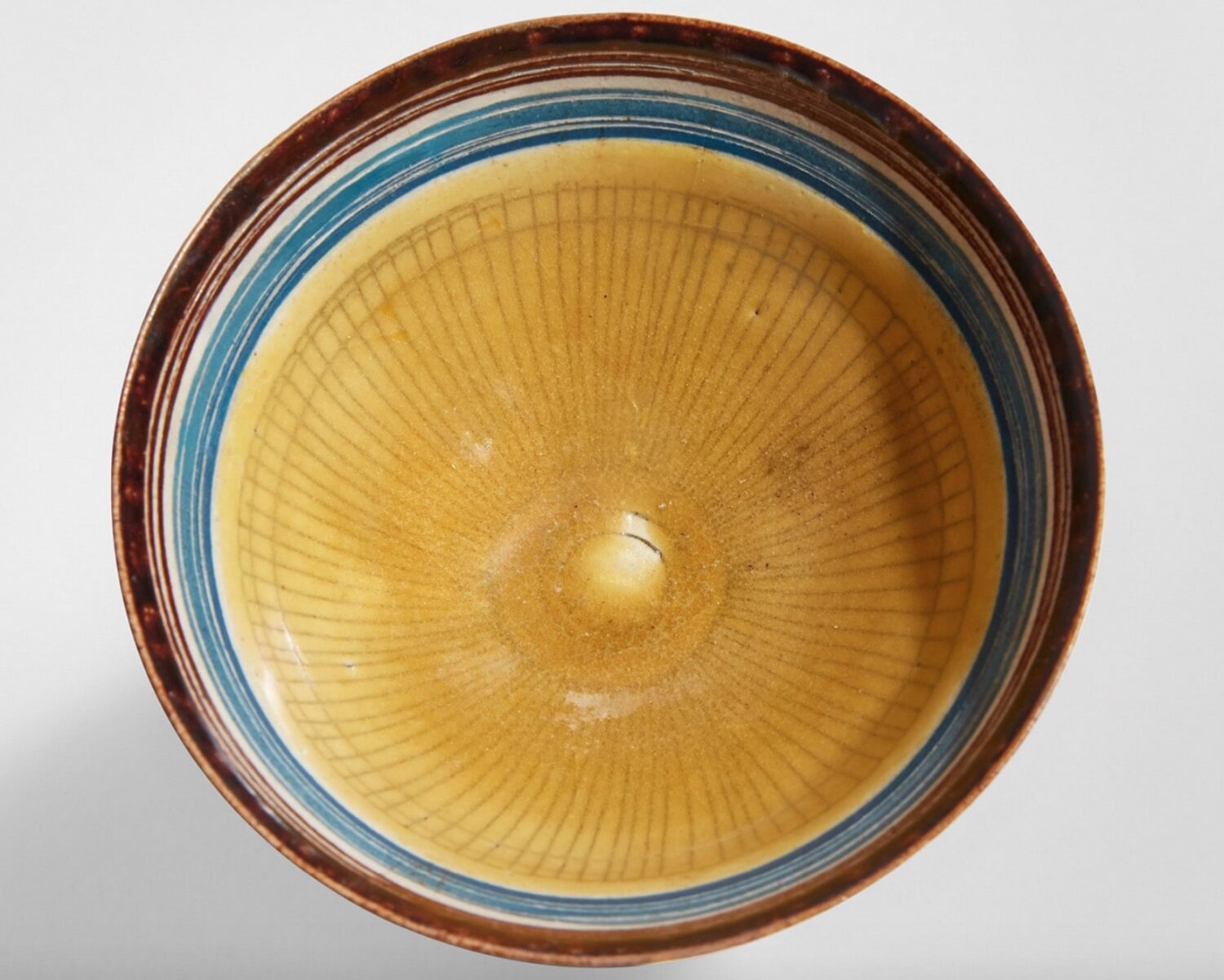
Lucie Rie
Conical bowl
circa 1960
Porcelain, manganese glaze with sgraffito on exterior, yellow glaze with inlaid design on the interior, horizontal blue band repeated inside and outside.
2 in. (5.1 cm) high, 4 1/4 in. (10.8 cm) diameter
Underside impressed with artist’s seal.
Estimate: $6,000 – 8,000
SOLD FOR $10,080
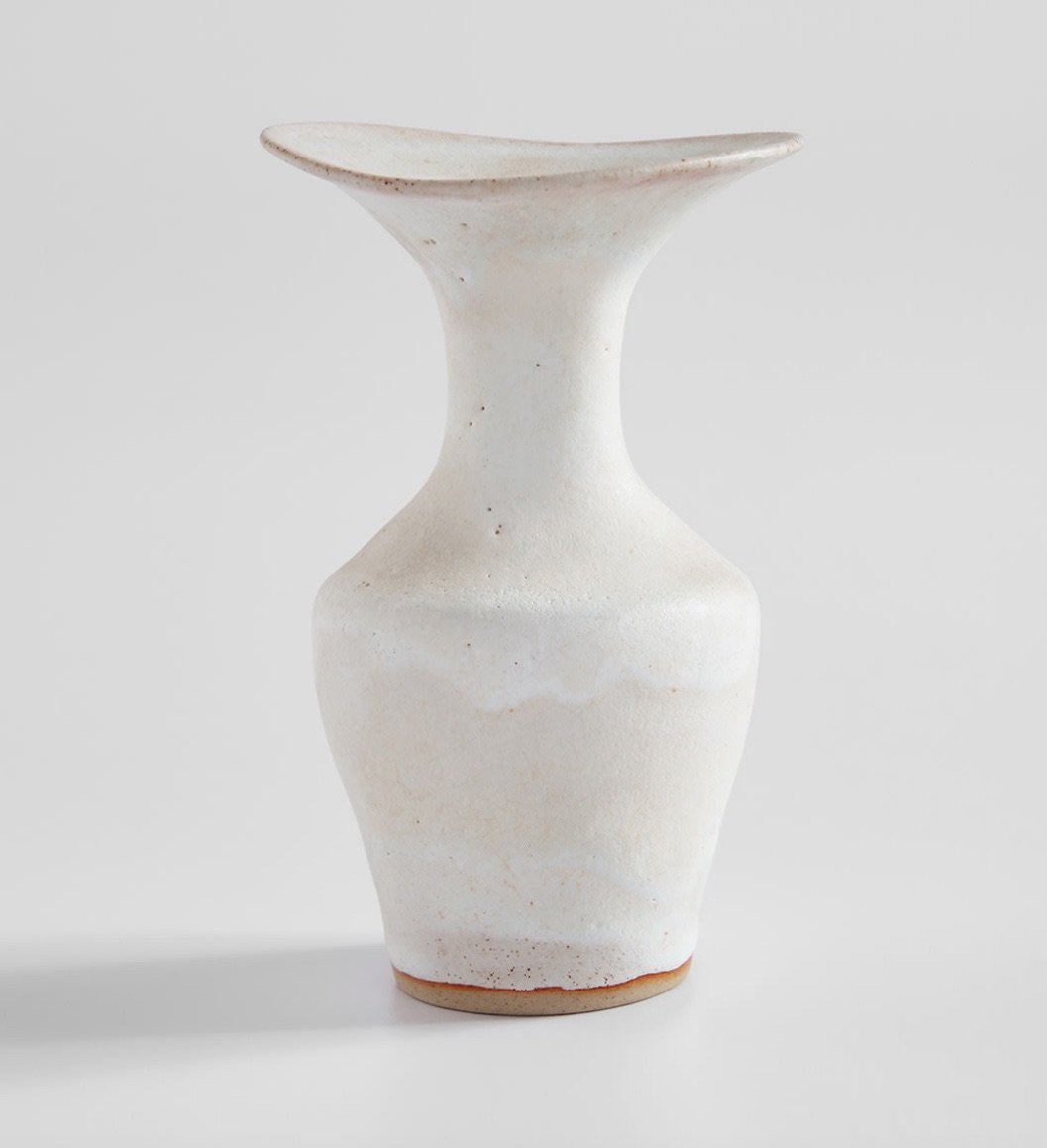
Lucie Rie
Small vase with flaring lip
circa 1976
Stoneware, flowing white glaze.
5 3/4 in. (14.6 cm) high
Underside impressed with artist’s seal.
Estimate: $3,000 – 5,000
SOLD FOR $5,292
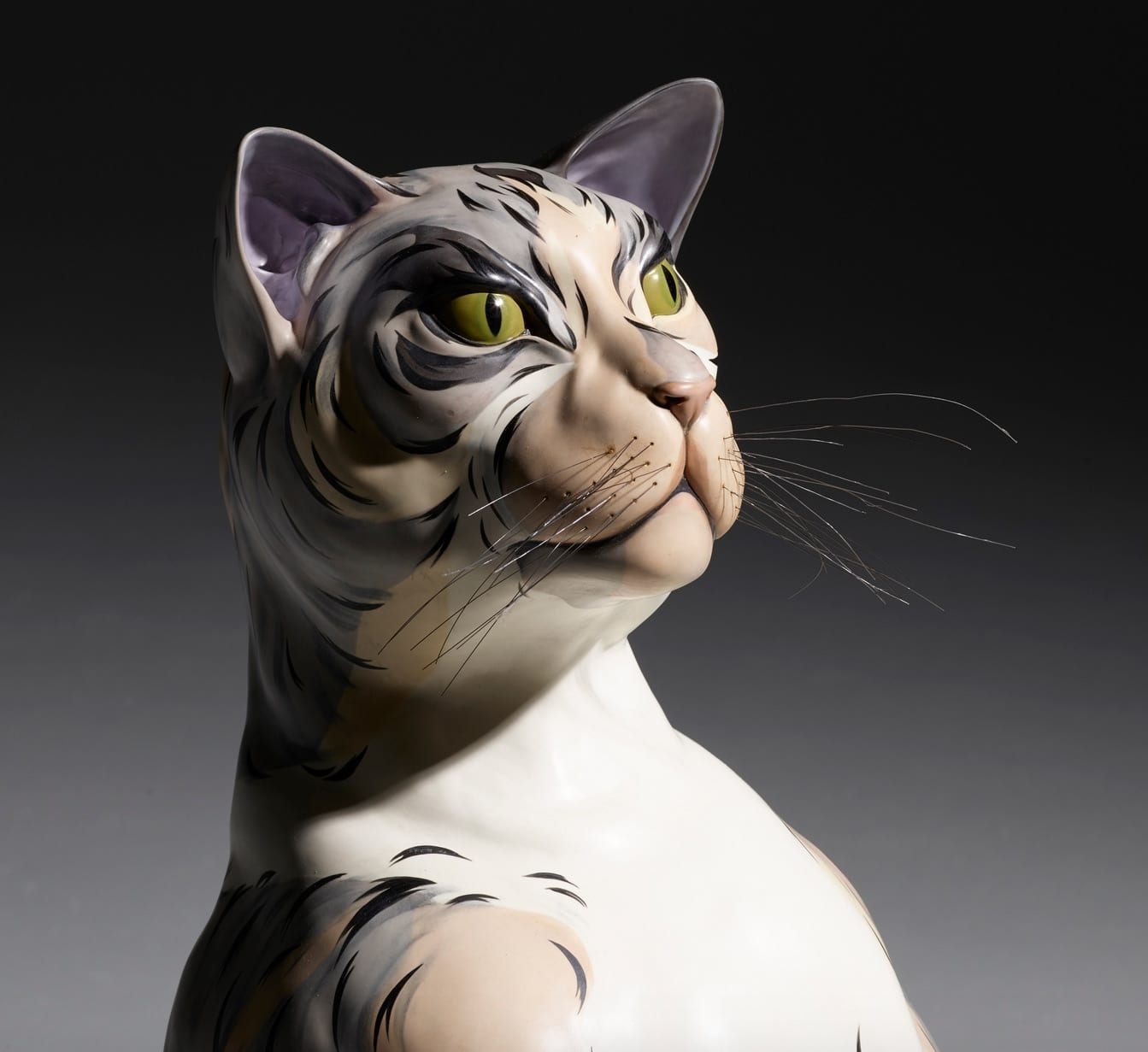
Thank you for mentioning the work of Lizbeth Stewart. They are two of the works I inherited from Liz’s estate and both of them are dazzling in person. Her expertise in painting was surpassed only by her ability to accurately fire and attach separate sections of these amazing large scale
animals and by her wit in storytelling.